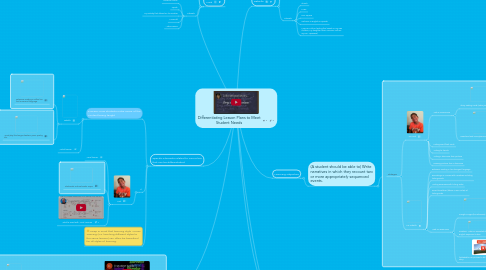
1. Videos give a good source of content for visual and verbal learners.
1.1. Content: Information that both students can learn from.
1.1.1. Isabella
1.1.1.1. Nick
2. Specific elements related to curriculum that can be differentiated
2.1. Process: How students make sense of the content being taught
2.1.1. Isabella
2.1.1.1. Extensive reading in either her first or second language.
2.1.1.2. Word play like tongue twisters, puns, poetry etc.
2.1.2. Verbal learner:
2.2. d
2.2.1. Nick
2.2.1.1. Visual learner
2.2.1.2. Flashcards: Picture books, maps.
2.2.1.3. What to avoid with Visual Learners
2.3. Keep in mind that learning Style "Cross Training"(i.e. teaching different styles to the same learner) can often be beneficial for all styles of learning.
3. Nick
3.1. Visual Learners
3.2. Readiness
3.2.1. In most areas, Nick is doing well. It was discovered recently that he has dyslexia. This is slowing down his reading and writing progress but not to a large extent yet.
3.3. Interests
3.3.1. Pokemon Cards
3.3.2. Sports
3.3.3. Any activity that allows him to socialize
3.3.4. Minecraft
3.3.5. Video Games
4. Two different students with different styles. Mouse over the cursors to see a partial profile.
5. Discovered by, among other things, a survey.
6. Learning Objective
6.1. (A student should be able to) Write narratives in which they recount two or more appropriately sequenced events.
6.1.1. Strategies
6.1.1.1. For Nick
6.1.1.1.1. Web 2.0 Resources
6.1.1.1.2. Linking word flash cards
6.1.1.1.3. Writing to friends
6.1.1.1.4. Writing a discourse from pictures
6.1.1.1.5. Drawing pictures from a discourse
6.1.1.2. For Isabella
6.1.1.2.1. Extensive reading in her strongest language.
6.1.1.2.2. Recordings or movies with narratives including linking words.
6.1.1.2.3. Writing excersizes with linking verbs
6.1.1.2.4. Direct translation (taboo in ESL circles) of linking verbs.
6.1.1.2.5. Web 2.0 Resources
7. Learning profiles
7.1. ELLs. They need lots of context to understand instruction. New vocabulary needs to be emphasized. Reading can be easier than listening for some students.
7.1.1. Provide background knowledge, sometimes with native language support, to allow ELLs to tie new information to something familiar. This helps students as they decode information; first trying to understand in their native language, and then transferring that understanding into English.(EDMENTUM, INC.)
7.1.2. Define key vocabulary, multiple-meaning words, and figurative language ((EDMENTUM, INC.)
7.2. Students with dyslexia (Almost everything I've found about dyslexics goes for ELLs!)
7.2.1. Provide visual representation of all oral instruction whenever possible.
7.2.2. Provide one step directions at a time.
8. General Class interests
8.1. Role Playing Game Cards (Boys)
8.2. Riding a bike
8.3. Watching cartoons
8.4. Drawing and coloring
8.5. Playing with friends
8.6. Mine Craft
8.7. Computer games
8.8. Play House (Girls)
9. Isabella
9.1. Definition of Verbal Learners
9.2. Readiness
9.2.1. Isabella went to first grade in Mexico. She was above grade level at her previous school. She excelled in Spanish in particular. She has picked up English quickly. She's made it to an intermediate level at a remarkable speed. She needs further mastery of English, however, to resume her academic successes.
9.3. Interests
9.3.1. Church
9.3.2. Music
9.3.3. Four Square
9.3.4. Cartoons in English or Spanish
9.3.5. Mexican Culture (writing this based on my own children; My daughter loves American culture, my son, Japanese.)

